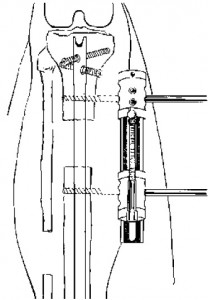{:it}
Allungamento con fissatore esterno e chiodo endomidollare
Tale tattica comporta l’infissione di un chiodo endomidollare ed una osteotomia prossimale con bloccaggio del chiodo solo a livello della parte prossimale della tibia; si applica un fissatore esterno che sarà il motore dell’allungamento. Raggiunta la lunghezza desiderata, si interviene chirurgicamente e si blocca il chiodo nella parte distale e si può rimuovere il fissatore esterno. Raggiunta la consolidazione, il chiodo deve essere rimosso.
La procedura descritta ha il vantaggio di avere il fissatore esterno impiantato per minor tempo mentre i problemi della rigenerazione e della contrattura muscolare rimangono mentre esiste anche un rischio di infezione del chiodo per la vicinanza con i chiodi e fili del fissatore (in percentuale della letteratura attorno al 3-4 %).
Leg Lengthening with intramedullary (internal) nail over external fixator, LON
The nail is inserted in the leg (femur or tibia) and after the osteotomy (cut of the bone) it is fixed proximally with screws. A mono lateral external fixture is positioned spanning the osteotomy site. Lengthening is achieved distracting the external fixator and once the desired length is reached the nail is blocked distally during a small operation and the external fixator removed.
This method is quite comfortable for the patients, especially after removing the external fixator. Muscular contractures are still possible as for all other techniques. The operation is longer with respect of HEF, there is a considerable blood loss and carries the risk of fat embolism. In case of delated consolidation there is the option od compressing the new forming bone before removing the external fixator. Rarely bone graft is needed.
At the end of the treatment, when a solid consolidation of the new bone is achieved the nail is removed.
Advantages
The frames can be removed earlier (around 5-7 months after surgery)
Down points
Lengthening the tibia with a nail is often associated with permanent anterior knee pain.
This method is more expensive (almost twice the cost of an external fixator even thought less expensive with respect of intramedullary extendable nails) due to the cost of the nails.

Possible risks of this procedure:
- Pin and deep bone infection (this is the worst down point and account for up to 3% of cases according to literature)
- Delayed bone consolidation needing a second procedure such as bone grafting
- Deformities needing further surgery
- Metalwork fatigue and break
- Fracture during the surgery. This complication have never been experienced by our patients but are described in the literature. This will need to stop the lengthening and deal with the fracture.
- Muscles contractures
- Neurovascular problems due to blood vassels or nerve stracchino. This complication have never been experienced by our patients but are described in the literature.
Do not hesitate to contact us for further questions{:}{:ru}
Удлинение с помощью внешнего фиксатора и интрамедуллярного ногтя
Эта тактика включает в себя введение интрамедуллярного ногтя и проксимальную остеотомию с фиксацией ногтя только на уровне проксимальной части большеберцовой кости; применяется внешний фиксатор, который будет двигателем
удлинения. Когда желаемая длина достигнута, операция выполняется,
и гвоздь блокируется в дистальной части, и внешний фиксатор может быть удален. После закрепления гвоздь необходимо удалить.
Преимущество описанной процедуры заключается в том, что внешний фиксатор имплантируют в течение более короткого времени, в то время как проблемы регенерации и мышечной контрактуры остаются, в то время как существует также риск инфекции ногтей из-за близости к ногтям и проволоке фиксатора (в процентах от литературы вокруг на 3-4%).
